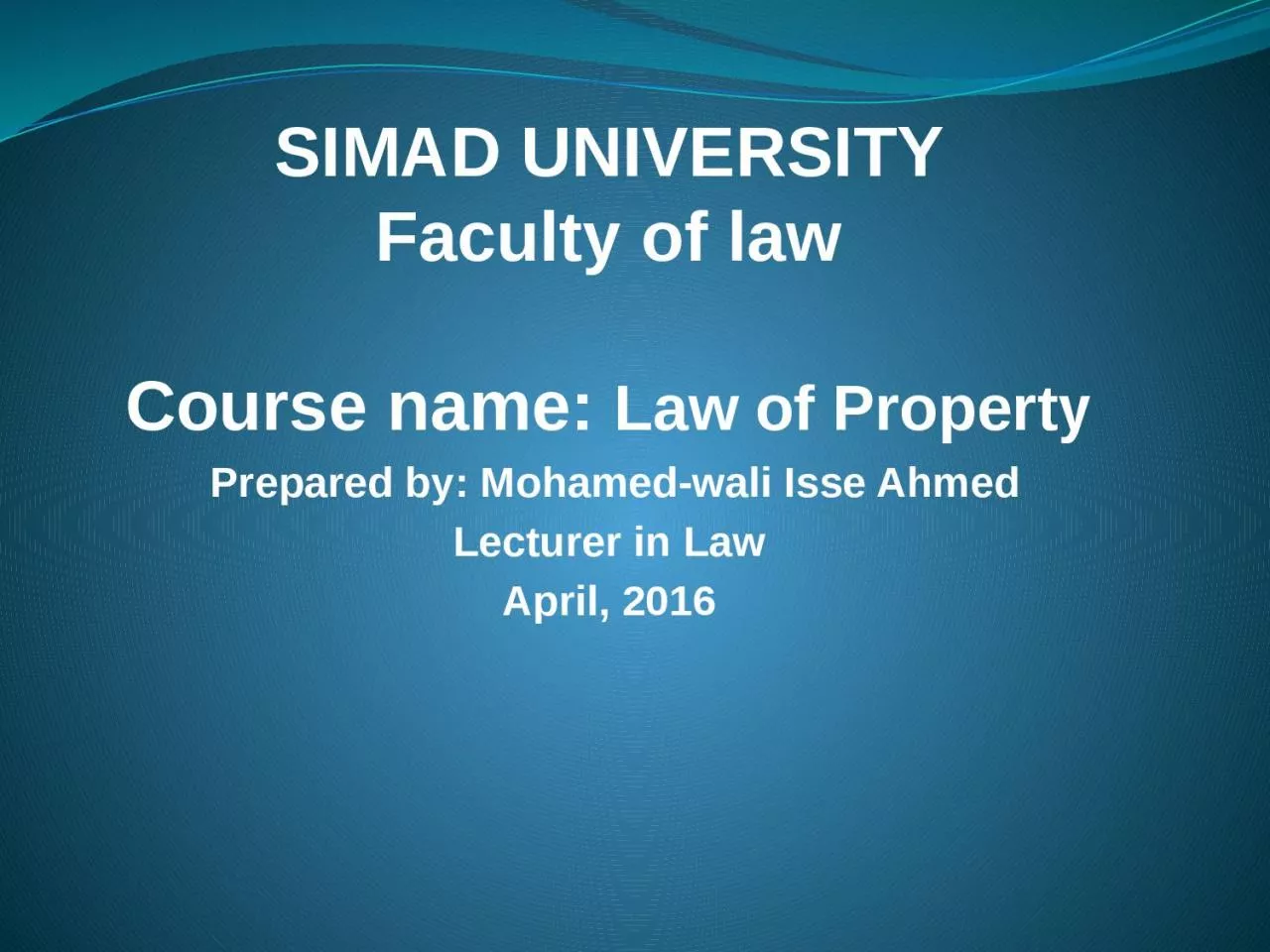

Course name Law of Property Prepared by Mohamed wali Isse Ahmed Lecturer in Law April 2016 Chapter 4 Jointownership The following are to be covered in this chapter Definition of jointownership ID: 1020093
Download Presentation The PPT/PDF document "SIMAD UNIVERSITY Faculty of law" is the property of its rightful owner. Permission is granted to download and print the materials on this web site for personal, non-commercial use only, and to display it on your personal computer provided you do not modify the materials and that you retain all copyright notices contained in the materials. By downloading content from our website, you accept the terms of this agreement.
1. SIMAD UNIVERSITY Faculty of law Course name: Law of Property Prepared by: Mohamed-wali Isse AhmedLecturer in Law April, 2016
2. Chapter 4 Joint-ownershipThe following are to be covered in this chapter:Definition of joint-ownershipScope of rules govern joint ownershipAdvantages and disadvantages of joint-ownership Source of Joint-ownership Rights and duties of joint-ownersSpecial cases of joint-ownership
3. Definition of Joint-ownershipJoint ownership or Co-ownership is the right of ownership exercised by two or more persons in relation the same object.it refers to the right of use and enjoyment, right of possession and exclusion of others and the right to transfer a thing or to charge it with pledge or mortgage exercised jointly by several persons.
4. The following are the main characteristics or natures of joint ownership; - the thing, which is jointly owned, is undivided; andeach joint owner is considered as owner of each and every part of the thing.Share of joint owner is deemed equal unless otherwise agreed.
5. Scope of rules governing joint ownershipThe rules on joint ownership are developed and applied to cases where the relations between the co-owners are simple relations of common interest in a thing.There are other joint-ownership made by person for reasons of business which are regulated by agreement such as partnership agreement. the rights and duties of joint ownership a are regulated by an agreement which is not contrary to rules of joint ownership in civil code. if there is not an agreement; then rules of of joint ownership in civil code shall apply.
6. Advantages and disadvantages of Joint ownershipAdvantages:Joint ownership helps people to acquire things in common in which a person cannot acquire alone. Joint ownership also helps in achieving efficient utilization of scarce resources.Disadvantages:joint ownership may hinder the free transfer of goods because of the guiding principle which is “joint owners shall, acting together, administer the thing jointly owned”
7. Source of Joint ownership Joint ownership may arise from a contract, will and the provisions of the law.joint ownership Arising from Contracts:A contract is a common source of joint ownership. Two or more persons who intend to acquire and use a thing commonly or jointly may enter in to a contract creating joint ownership.Joint Ownership Arising from the Law : Joint ownership may also arise from the provisions of the law. For instance, inheritance where it remains in common between heirs until divided among them.
8. Rights and duties of joint ownersRights:Right to use and enjoy the Undivided property, and its FruitsRight to administer the thingthe consent of the other joint owners is required in relation to administration of the thing;no joint owner can exercise any right or physical act on thing that implies the existence and exercise of complete individual ownership;Decisions are made by majority vote of joint owners who represent majority share in the thing jointly owned.
9. c. Each joint owner has the right to dispose of his share of rights in the undivided interest in the thing jointly owned. there is a difference between the right to dispose of the thing, which require unanimous decision of all co-owners, from the right dispose of ones share in the thing jointly owned. d. Each joint owner has the right to request termination of joint ownership and this right can be waived by an agreement only for five years.
10. Duties: Each co-owner shall bear, in proportion to his/her share, the costs of administration, taxes and necessary costs (costs incurred to avoid lose or damage to the thing). Each co-owner has right to force other co-owners to reimburse him with necessary expenses.
11. special cases of joint- ownershipPerpetual joint ownershipPerpetual joint ownership represents a joint ownership in which joint owners do not have the right to demand termination. Perpetual usually exists in relation to indispensable accessories of things intended for the common use of two or more estates belonging to different owners. Example are lanes, passages, yards, wells, sewer pits, paths, roads, dams, canals, party walls, and common portion of condominium houses.
12. Party walls:A party wall is a wall placed on the boundary line between two estates, and belonging in common to their owners, including the land on which it rests.Party Co-ownership of ditches: Any ditch separating two estates is considered party co-owned, unless only one of these estates is enclosed, or there exists a documentary title or a prescriptive title. Party Co-owned hedges: Any hedge, live or dry, which serves to separate two estates is presumed to be party co-owned, unless only one of the estates is enclosed or unless there exists a documentary title or prescription.
13. Co-ownership in buildings in which floors or apartments are separately owned:Parts of the building that are not intended for the exclusive personal use of one owner are presumed to be commonly owned. For example the structural walls, the roof, the staircases, the elevator and walls separating two houses or rooms belong to both owners as party walls. However, windows, shutters, and blinds, doors of the rooms and balconies are individually owned.